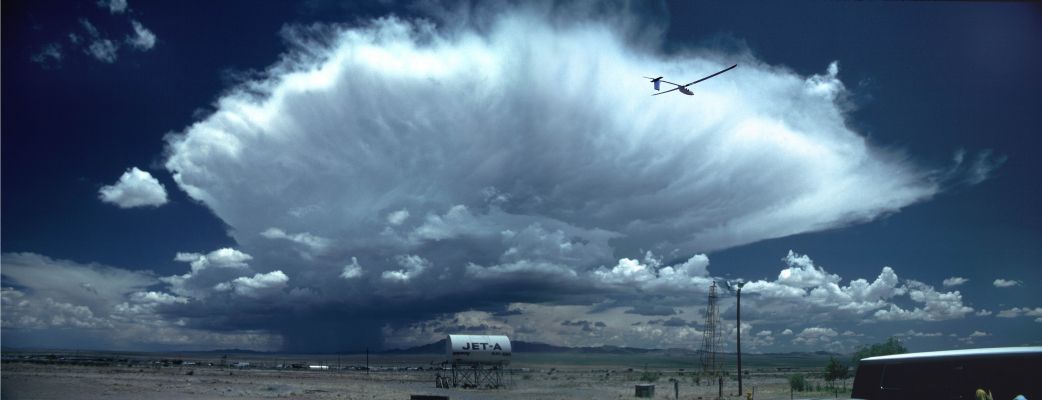 photo: RC Dave
photo: RC Dave
Interview with Hang Gliding / Photography Legend Eric Raymond
© John Heiney
 photo: RC Dave
photo: RC Dave
© John Heiney
When I started flying in 1978, Eric Raymond was already a hang gliding legend in his own time. Eric was the man everyone respected. He made beautiful hang gliding photographs. He made his own harnesses. He built his own gliders. He looped hang gliders. He won contests. I remember just wanting to be like Eric Raymond. Eric was a pilot’s pilot, and he still is.
After about fifteen years of being a major influence in hang gliding, Eric decided to design and build his own solar-powered electric sailplane. When finished, he flew it across the United States. His plane, the Sunseeker, stood as the only working electric airplane in the World for many years. Last year, Eric moved to Switzerland to work for Solar Impulse, a group that intends to build a 4-motor electric airplane to fly around the World. During his recent visit back in the USA, I took the opportunity to ask him these questions:
What got you started hang gliding?
I was flying model airplanes and got into radio-control. I tried sailplaning, but that was kind of a disappointment from the model airplanes. I saw pictures of hang gliding and it looked like the thing for me. I got some plans and built my own glider. I bought the sail and started hang gliding. The plans and sail were from Sky Sports.
When did you start flying hang gliders?
1974
Why have you continued to fly so long?
Because I like it. It’s an athletic sport. In flying sailplanes for example, you’re just sitting there twiddling controls. Hang gliding is a perfect dynamic sport where you get lots of athletic exercise.
Your life seems to be all about flying. Is there a history of flying in your family?
No. There is a history of engineering and inventing. My grandfather invented the fist automatic doors that opened by so-called “magic eye”. My father, the oceanographic engineer made the first deep-sea cameras that photographed the Titanic, and a lot of other deep-sea equipment.
What other aircraft have you flown?
I got a sailplane rating, commercial and flight instructor in gliders. I owned a Stemi, which is a sophisticated motor-glider, but you can fly it with a sailplane rating. Just hang gliders and sailplanes. Oh! And the human-powered airplanes.
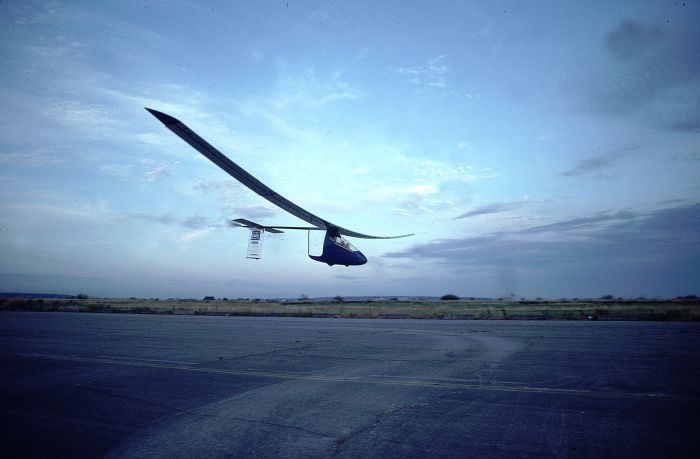
I was invited to fly the two fastest human-powered airplanes. I was working with Paul McCready’s group. They invited me to fly the Bionic Bat just before it got retired. Then, in Europe I was invited to fly the Musculair II just before it was retired. That was a revelation for me to fly those flying bicycles that were so fast. I remember I could barely keep up with them on a racing bicycle.
When were you born? October 1956
Where were you born? Tacoma WA. My dad was working for Weyerhaeuser.
Where do you live?
I am living in Slovenia with my girlfriend, who is a competition sailplane pilot and instructor.
(Eric is now married)
Where did you first fly hang gliders?
Near the high school I was going to in Maine, there was a Bill Bennett dealer named “Sky Truckin’”. They came to the high school and gave one-day lessons on Bennett “standards”.
How old were you when you started hang gliding?
Eighteen.
Who was your instructor?
Just those guys from Sky Truckin’ that one day.
Have you had any serious injuries? I broke my arm hang gliding. I broke my pelvis paragliding.
What is your personal best XC flight?
I guess it would be in the Voyager when I did the 121 miles in 1980. For that time, it was the best flight.
Do you know how many hours you have?
No. Thousands. (smiles)
Do you have a most memorable flight?
In a hang glider, It would probably be when I flew from the middle of Switzerland into Austria. I wish I had started a little earlier. We knew there was a cold front coming. I was just trying to stay ahead of this frontal activity, so I was flying really fast over the most scenic terrain, right down the core of the Alps.
Do you have a favorite flying site?
Fiesch Switzerland
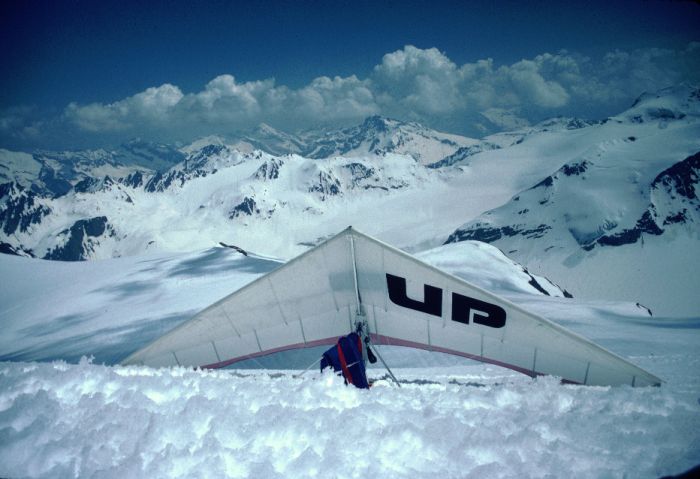 |
This is Eric's Comet 2 after landing on a glacier above Fiesch to camp for the night. photo Eric Raymond |
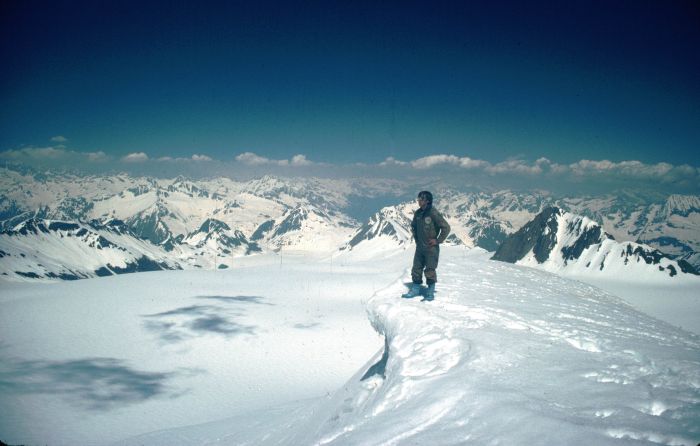 |
Eric after landing high in the Alps to spend the night. His goal was to take a trans-Alps camping trip on a hang glider, but weather did not cooperate. photo Eric Raymond |
What launch sites did you fly in the early days that are not accessible today?
Point Fermin in San Pedro was a really amazing place to fly hang gliders. Escape Country. Imagine a sports utopia with dirt-biking, skate-boarding, hang gliding, etc right in the neighborhood of Los Angeles. Too good to last.
Did you have photography experience before you started flying?
Yes. My father was a photographer. I always had a camera from as long as I can remember. I went to college for professional photography, but I dropped out after two years to pursue my hang gliding career. I’m glad I did, because I was US National Champion by the time I would have graduated. I would rather be Hang Gliding Champion than have a degree in photography.
Why did you start taking photos of hang gliding?
Well, they were really pretty. I started, even with my standard to figure out ways to activate the camera remotely, so I could mount it on the nose or the tail or the wing of the glider. That was real fun.
JH Leroy Grannis told me that Bob Keeler was the first to mount a camera on a hang glider.
ER Well, the Wright Brothers did that too. (laughs) There were cameras on balloons before the Wright Borthers. There is footage from the Wright Brothers.
When did you first come to Torrey Pines?
My Dad brought me on a business trip to Scripps Institute of Oceanography in 1975.
Tell me about that day. What glider were you flying? Who else was flying here then?
I had my standard Rogallo and flew it several times per day to the beach. On the last day I soared for maybe an hour, but I still landed on the beach. I know Rick Finley was there because he took off right in front of me in his Wind Lord, which they called the “spin lord”. The wind was light and it looked perfect. The thing yawed 180 degrees and crashed right back into the cliff below launch.
What does hang gliding mean to you?
Well, it is a very free, unfettered, unregulated form of flight. It’s a very pure form of soaring. To me, one of the best ways to fly.
Have you worked for other hang glider manufacturers besides UP?
I worked in England for Airwave Gliders for a year and a half, developing a carbon fiber rigid-wing. Funny thing is, their mandate sounded just like what the ATOS now is. A weight-shift rigid-wing. I told them it was impossible. It had to be hand controls. They wanted weight-shift. I didn’t quite have the imagination to do what some other people later did.
What gliders have you flown in your career?
What gliders? All of them! When I was living at Torrey Pines we would exchange gliders all the time, so I flew Phoenix 6, 6B, 8, 12. I did fly two sizes of the Phoenix Mariah. UP Spider, Condor, Mosquito, Comet, Comet 2, Glidzilla, Axis, Japanese Axis. Wills Wing Omega, Raven, I had an XC for a while. Later, I flew the Sport. Peregrine Owl, Electraflyer Olympus. I changed over to rigid-wings in 1979 and flew mostly rigid-wings for the next several years. I flew the Fledge, Voyager, Sunseed, UP Arrow. Then, after the Arrow I flew the Comet flex-wings.
How much did you pay for your first hang glider?
I can’t remember what the parts were, but the sail might have been 150 dollars.
Have you “pioneered” any sites?
I can’t think of any. I tended to go to the established sites. There were plenty of them then.
Actually, with my sky camping, every time I landed somewhere to camp and relaunched, I was doing it where no one else ever had. That was all in the Alps. I did do some sky camping in the Owens, but it seemed really dangerous to me. The Alps is a totally different situation.
Was hang gliding more fun in the single surface days?
I would say so. It was a lot less equipment. We were flying at the beach. I’ve been giving slide shows in Europe, and I show people flying bare-foot with no helmet and no vario. They think it’s incredible flying with just a bathing suit over the beach.
It seems like a totally different sport to me to be able to use it like a beach toy. Now, we go so high that we suffer from the heat when we’re down low and the cold when we’re up high. We have all this extra equipment.
JH Some people don’t consider beach flying a valid form of flying for some reason.
ER Hmmm. When I was working for Airwave in England I was flying coastal cliffs down to almost nothing. The English pilots thought I was daft. They wanted to go to Wales and fly the wave lift and get really, really high. They were just overlooking this beautiful sea breeze they had every day. I’m definitely a coastal pilot.
You developed Anchor Magnan’s cocoon harness invention into a variable angle-of-attack, practical harness that was the industry standard for years. You modified your cocoon design to make an enclosed harness that lead to the pod harnesses of today. Your modification of the Comet design resulted in your “Batten-Bomber”, which was the first easily loopable flex-wing glider. Your version of Bob Trampenau’s “Sun Seed” design performed far better than any production glider of the time. You did intentional tumbles on your Sun Seed which has not been duplicated until today’s acro paragliding. What are your thoughts about your accomplishments?
Mostly, I have looked for good ideas high and low. For example, with the Voyager I used the mylar leading edge pocket I had seen on Gerard Thevenot’s Atlas. I used the “sunken” rib pockets that Bob Trampenau had invented. Jim Hanbury was the first person to move the wires to back of the leading edge. Believe it or not, the side wires used to bolt to the front of the leading edge. Jim moved them to the back, a seemingly simple thing, but now you have to figure out where to put a hole in the sail for the wire. Mostly, I put together ideas from other people.
I did invent the trailing camera system that you see used on paragliders and hang gliders, where you are towing a camera that is pointed at you at all times. By applying the correct G-forces, you can get the camera up on the horizon or even straight above you.
 |
This is Eric competing in the Illinx Aerobatics Meet in Monaco. |
Did you win the Owens Valley contest in which you flew the UP “Arrow” ultra-light sailplane?
What competitions have you won?
I finished in a 3-way tie for first in the Southern California Regionals in ‘79. I won the US Nationals in ’79, the Great Race in ’79, Owens Valley Open in 1980, the Southern California Regionals in ’80(rigid wing class), Southern California League meet in 1982(a 3-man team), the Telluride World Aerobatics Championships in ’83 & ’84, and the first European Aerobatics Championships in 1984, and maybe some others I’ve forgotten.
What do you do for fun or reward besides hang gliding?
Wind Surfing, in the surf!
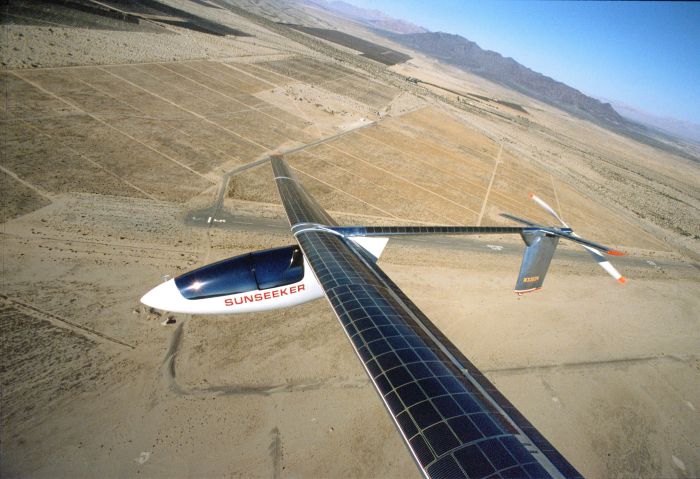
What do you do for a living?
I’ve been building various prototype aircraft for people for many years now. It is really advanced composite stuff, and getting more and more into solar cell integration into composite aircraft. I’m even hoping to do some solar powered boat projects.
You took your Sunseeker to Europe with you. What have you done with it there?
I flew it without a ground crew in 2008 and had good flights. Then I spent the winter upgrading it in every way. New batteries, new instrument panel, three collision avoidance systems, On April first I went on a European tour and flew it over the Alps on April 14th from Zurich to Torino Italy. Then continued down to Sicily in about five steps. We started again from Zurich and flew to Vienna and down to Slovenia to the National Sailplane Championships.
We started again in Zurich and flew down to the southern coast of Spain almost to Gibraltar. Then one last week in the Alps, flying over the Matterhorn, the highest glaciers and whatnot. (See photos and videos of this adventure and Eric’s current projects at solar-flight.com)
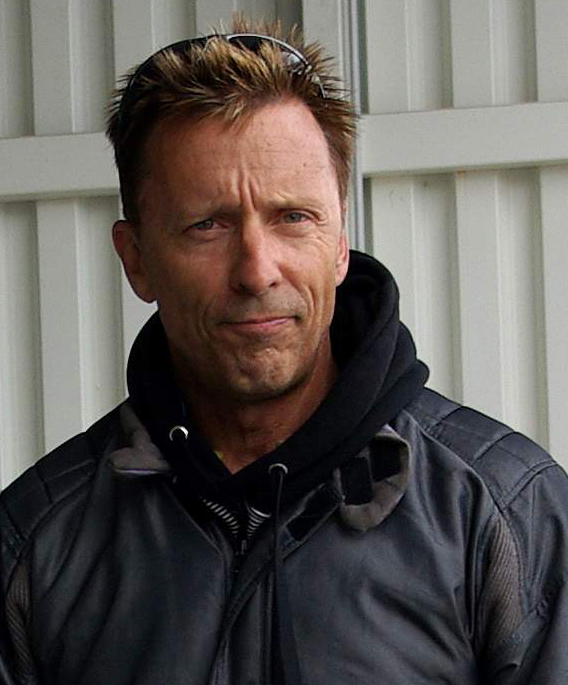
What is the best thing that has ever happened to you?
Learning to fly. I was born to fly.
What is the worst?
My paragliding accident was pretty bad. My divorce was equally bad. They both nearly killed me.
What is the most rewarding thing you have ever done?
Designing, building, and test-flying my own solar-powered airplane, and demonstrating to the World that this can be done.
If you could change anything in your life, what would you change?
Only one thing? (laughs) I would stay away from the stock market. I am pretty lucky and happy. I really haven’t had any bad experiences. There would be nothing much to change.
What is the wildest thing that has happened to you while flying?
It would be getting momentarily flipped over in the hang glider in Venezuela. I just hung on, pulled in and recovered. I can think of one other occasion where the glider just went right upside down.
Actually, that’s not true. I would say the wildest thing was during a flat spin at Crestline where the glider(a Comet highly modified for racing) stopped spinning and just tucked and broke. I went down under canopy in Devil’s Canyon Power Plant, for the second time in my life.
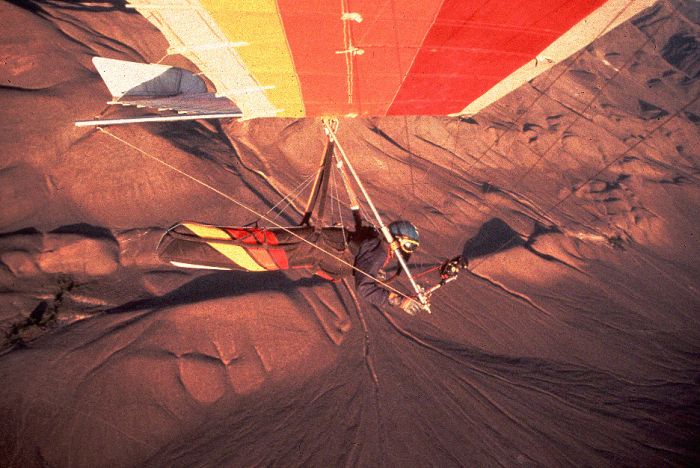
What is the craziest thing you have ever witnessed in hang gliding?
I would say watching Dick Cassetta launching at Gunter in Owens Valley. There was a tiny little dust devil coming up the hill. It looked perfect. He had one of my cocoons and just as he kicked into the boot and went prone, he went straight into a loop, because he hit the dust devil. He came back so close to the launch that the people who were helping him went running to the sides ‘cause it looked like he was going to hit the ground.
He cleared the ground, but then he hit the dust devil a second time and went into another loop and came even closer to the hill. During this loop he yawed the glider 90 degrees, so he came out parallel to the hill so he wouldn’t hit the dust devil a third time.
Do you have any more stories to tell me?
I had a rigid wing hang glider with diffuser tips and I tried to do forward tumbles with it. I thought the glider was strong enough to handle the loads of a tumble. It had big elevons which when tipped down would make a flying wing nose down radically, which was my intention. I built a harness with three carabiners. One you hook in normally. The others you hook in to the other two corners of the control bar after launch. You are just suspended in the triangle when you go upside down.
I did some tumbles and found that I could not do just one. It tumbled so quickly that I had to give the recovery input while going straight up in order to recover going near straight down. When I was testing it at the “E” I did three tuimbles, witnessed by Dangerous Dave and I broke one downtube. Turns out the glider flew fine with one downtube, so I landed it that way.
The fourth time I did these tumbles I got into a horrible side slip and the diffuser tip caused the glider to go upside down and it broke. I went down in Devil’s Canyon Power Plant again. My favorite place to crash(laughs).
Have you made more outstanding accomplishments that I have overlooked?
I brought sky camping to Europe which is now a Red Bull sport for paragliders. It inspired Didier Favre to do it in a hang glider, eventually from the French Mediterranean along the Alps into Yugoslovia. I had many photos published in hang gliding magazines Worldwide, including 25 covers on, and many centerspreads in Hang Gliding. In the early days I had the altitude gain record of 15,200 feet.
What is your philosophy of Life?
I’m not afraid to die, but I am afraid not to live. You’re going to die anyway, so you might as well live while you can.
First published in July 2010 HANG GLIDING & PARGLIDING Magazine
FURTHER STORIES FROM ERIC NOT IN THE MAGAZINE ARTICLE:
On the flight in the SUNSEEKER across the USA, it became more and difficult to stay up on the solar power as I got to the east because it was hazy. For this reason the Japanese contingent of my support crew who was following me in a small plane called Missouri (pronounced "misery"). There I was below 1,000 feet for over a hundred miles.
As I approached the Appalachians, low clouds and haze forced me to find the "Cumberland Gap". I was flying with three friendly ravens that I thought that I had seen the day before, when I decided to climb in a thermal into the cloud. As I concentrated on my blind flying instruments, I noticed the three birds hovering just outside my window. They stayed with me the entire time in the cloud, sometimes slope soaring the leading edge of my wing.
With SUNSEEKER II, I have much higher power, so I have never needed to climb inside clouds. Almost every flight I do climb up between the clouds.
I crossed the Alps April 14, which was quite early in the year considering the long winter this year. The cloud based very very low, but after I got on top it was smooth sailing, until it started clouding under completely. My GPS showed that I was past the highest ridges so I kept climbing on course for Torino. The problems started when my path was blocked by rising towers of cumulus. I noticed what I thought was a bank of high clouds, but soon discovered that I was in a blizzard! Snow with bright sunshine.
Finally my path was blocked even for a retreat, and I did not like the idea of flying into these clouds, but I found a small hole, through which I could see only snow and trees.
I set the airbrakes and spiraled down 7000 ft. (photo attached, later e-mail). It felt like I would need to descend all the way to the mountains, but soon I reached cloudbase and continued on my way. I even saw a paraglider and a sailplane in the gloomy overcast.